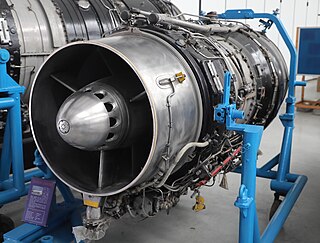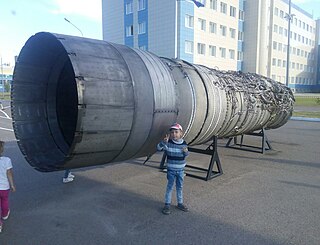
The Lyulka AL-21 is an axial flow turbojet engine created by the Soviet Design Bureau named for its chief designer Arkhip Lyulka.

The General Electric/Allison J35 was the United States Air Force's first axial-flow compressor jet engine. Originally developed by General Electric in parallel with the Whittle-based centrifugal-flow J33, the J35 was a fairly simple turbojet, consisting of an eleven-stage axial-flow compressor and a single-stage turbine. With the afterburner, which most models carried, it produced a thrust of 7,400 lbf (33 kN).

The Tumansky R-11 is a Soviet Cold War-era turbojet engine.

The Tumansky R-13 is a Soviet turbojet engine designed by Sergei Alekseevich Gavrilov.

The Lyulka AL-7 was a turbojet designed by Arkhip Mikhailovich Lyulka and produced by his Lyulka design bureau. The engine was produced between 1954 and 1970.

The Tumansky RD-9 was an early Soviet turbojet engine, not based on pre-existing German or British designs. The AM-5, developed by scaling down the AM-3, was available in 1952 and completed testing in 1953; it produced 25.5 kN (5,700 lbf) thrust without afterburner. AM-5 engine is notable for making possible the first mass-produced supersonic interceptor, the MiG-19, and the first Soviet all-weather area interceptor, the Yak-25. When Sergei Tumansky replaced Alexander Mikulin as the OKB-24's chief designer in 1956, the engine was renamed RD-9. The engine was later built under license in China as the WP-6.

The Klimov VK-1 was the first Soviet jet engine to see significant production. It was developed by Vladimir Yakovlevich Klimov and first produced by the GAZ 116 works. Derived from the Rolls-Royce Nene, the engine was also built under licence in China as the Wopen WP-5.

The Tumansky R-15 is an axial flow, single shaft turbojet with an afterburner. Its best known use is on the Mikoyan-Gurevich MiG-25.

The Lotarev DV-2 is a two-spool turbofan engine manufactured in Považská Bystrica, Slovakia by Považské Strojárne Letecké Motory (PSLM) and designed in partnership with Ivchenko Lotarev Design Bureau.

The de Havilland Gyron Junior is a military turbojet engine design of the 1950s developed by the de Havilland Engine Company and later produced by Bristol Siddeley. The Gyron Junior was a scaled-down derivative of the de Havilland Gyron.

The Allison J71 was a single spool turbojet engine, designed and built in the United States. It began development in 1948 as a much modified J35, originally designated J35-A-23.

The Kuznetsov NK-32 is an afterburning three-spool low bypass turbofan jet engine which powers the Tupolev Tu-160 supersonic bomber, and was fitted to the later model Tupolev Tu-144LL supersonic transport. It produces 245 kN (55,000 lbf) of thrust in afterburner.

The General Electric YJ93 turbojet engine was designed as the powerplant for both the North American XB-70 Valkyrie bomber and the North American XF-108 Rapier interceptor. The YJ93 was a single-shaft axial-flow turbojet with a variable-stator compressor and a fully variable convergent/divergent exhaust nozzle. The maximum sea-level thrust was 28,800 lbf (128 kN).

The Kuznetsov NK-144 is an afterburning turbofan engine made by the Soviet Kuznetsov Design Bureau. Used on the early models of the Tupolev Tu-144 supersonic aircraft, it was very inefficient and was replaced with the Kolesov RD-36-51 turbojet engine.

The Motorlet M-701 is a Czechoslovak jet engine. It was used to power the Aero L-29 Delfín jet trainer, with about 9,250 engines built between 1961 and 1989.

The Williams F112 is a small turbofan engine made by Williams International designed to power cruise missiles. It has been used as the powerplant for the AGM-129 Advanced Cruise Missile and the AGM-86B advanced cruise missile, as well as the experimental X-36 and X-50.

The Kuznetsov NK-25 is a turbofan aircraft engine used in the Tupolev Tu-22M strategic bomber. It can equal the NK-321 engine as one of the most powerful supersonic engines in service today. It is rated at 245 kN (55,000 lbf) thrust. The three shaft engine we call the NK-25 was designed in the years 1972–1974. It is made by the Soviet Kuznetsov Design Bureau.

The General Electric J73 turbojet was developed by General Electric from the earlier J47 engine. Its original USAF designation was J47-21, but with innovative features including variable inlet guide vanes, double-shell combustor case, and 50% greater airflow was redesignated J73. Its only operational use was in the North American F-86H.

The Tumansky R-29 is a Soviet turbojet aircraft engine that was developed in the early 1970s. It is generally described as being in the "third generation" of Soviet gas turbine engines which are characterized by high thrust-to-weight ratios and the use of turbine air cooling.
The Tumansky R-21 was a Soviet turbojet engine of the 1960s. Used for development only, the project was canceled.



















